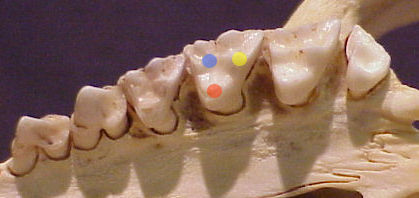Zoology 365
Biology of Mammals

Spring Semester, 2006
Terri McElhinny- Michigan State University
| Zoology 365 |
Biology of Mammals |
 |
||||||||
Spring Semester, 2006 |
Terri McElhinny- Michigan State University |
|||||||||
1. Use the information in your coursepack. Okay, so these images aren't so great, but I wanted to give you something that didn't have labels on it.
2. The last upper premolar and the first lower molar. P4/M1. Okay, so you can spit the numbers back at us, but can you IDENTIFY the teeth if asked? Check this link for help.
3. Premolars have deciduous and adult forms, whereas there are no milk molars, only permanent adult teeth. Premolars are usually more simple than molars, they are smaller and have fewer cusps and roots. However, there are cases when it is difficult to tell premolars from molars, and in this case we call them cheek teeth, collectively.
4. Incisors are rooted in the premaxilla. Canines, premolars and molars are rooted in the maxilla.
5. I 3/3, C 1/1, P 4/3, M 0/1. Can you identify the carnassial pair? This is a spotted hyena (Crocuta crocuta), by the way.
6.

red=protocone
blue=paracone
yellow=metacone
7.

red=protoconid
blue=paraconid
yellow=metaconid
8.
| dilambdodont (a) | (a) insectivore |
| zalambdodont (a) | (b) carnivore |
| bunodont (e) | (c) browsing herbivore (like a deer or goat) |
| selenodont (c) | (d) grazing herbivore (like a horse or tapir) |
| secodont (b) | (e) omnivore (like you) |
| lophodont (d) |
To go back to the Lab 1 Review questions, click here.
To go back to the main review page, click here.
For more information on many of these topics, check out the special topics pages of the Animal Diversity Web.